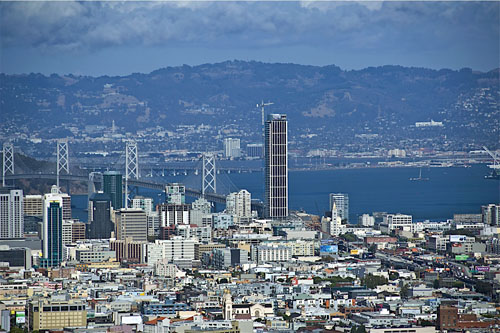
The developer for One Rincon Hill, a 62-story skyscraper
that juts out of the sky at the foot of the Bay Bridge,
says the $5 million in fees that were central to obtaining city approval
to build the high-rise will not be paid.
By April Veneracion and Chris Daly, special to FogCityJournal.com
April 20, 2009
From the penthouse suite atop One Rincon Hill, Michael Kriozere, the project’s developer, may feel that he soars over the rest of San Francisco. However, a deal is a deal, and we are doing everything within our power to make sure that this developer does not continue to operate as if he is above rest.
One Rincon Hill, a 62-story skyscraper that juts out of the sky at the foot of the Bay Bridge, serves as a stark reminder of the many impacts of this development to the City and surrounding neighborhood-physical, economic and social. With Kriozere’s recent talk of reneging, the tower is now a reminder that certain developers need their feet held to the fire to make good on commitments made for project approval.
Upon learning of Kriozere’s threats to not make his required payments to the City, we immediately contacted the City Attorney to alert him of the situation. As our office’s highest priority, we have asked the City Attorney to aggressively enforce the law requiring this fee to be paid.
The SOMA Stabilization Fund, established as law under the current Planning Code, imposes a $14 per square foot fee on residential development in Rincon Hill. These fees are to be paid with six months of issuing the final certificate of occupancy. The intent of this legislation was to require developers to pay fees soon after the sale of units began. Now with One Rincon 70 percent occupied, we have asked the Building Department why they have not yet issued their final certificate of occupancy.
Vivian Day, Director and Chief Building Inspector at Department of Building Inspection, expects the final certificate to be issued within the next two to three months. The City’s Zoning Administrator Larry Badiner is distressed to hear of the developer’s position and is following up and hopes for resolution by this Thursday’s Planning Commission meeting. The Mayor’s Office is making calls to the developer, and the City Attorney is investigating the City’s legal options, which may include placing a lien on the building.
In 2005, an historic agreement was reached to ensure development is accountable to the local community that is impacted by the long-term affects of newly proposed high rise projects. Though there was initially wide-spread community opposition to the Rincon Hill Area Plan, the South of Market Community Coalition was instrumental in working with my office to develop a solution for mitigating displacement impacts. The SOMA Stabilization Fund expanded the concept of community benefits beyond physical improvements to support the real diversity of the South of Market community. We knew that small business owners, low-income folks, Filipino families, and the neighborhood’s renters would never be able access condos priced at $1.25 million. Meanwhile, along with high-end development would come increased land values and associated spiked rents and evictions. The social pressures on the existing community would be exacerbated.
As recognition of these impacts and mitigation needed, nine of eleven Supervisors agreed to establish the SoMa Stabilization Fund as a condition of approval for the Rincon Hill Area Plan. Four years later, One Rincon Hill, the first of the Rincon Hill high rise projects is completed and has already made approximately $350 million in sales. Angelica Cabande of South of Market Community Action Network, puts it this way, “What’s owed to the City’s SoMa Stabilization is 1.5% of the current unit sales. The community deserves at least that.”
We couldn’t agree more.


 The Hunger Site
The Hunger Site
April 21, 2009 at 8:01 am
Here’s the deal. Play ball with the Democratic Machine, or play somewhere else. No different than before, except now Chris Daly is the machine, not Willie, or Phil, or Diane, or Art.
April 20, 2009 at 4:42 pm
At last, I agree with Chris Daly. A deal is a deal. Hold this guy to it.
April 20, 2009 at 3:59 pm
Why not confiscate some of the “unsellable” 30% of the building still unoccupied and redistribute it to low income tenants?